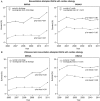Temporal trends in out-of-hospital cardiac arrest survival outcomes between two metropolitan communities: Seoul-Osaka resuscitation study
- PMID: 26059524
- PMCID: PMC4466758
- DOI: 10.1136/bmjopen-2015-007626
Temporal trends in out-of-hospital cardiac arrest survival outcomes between two metropolitan communities: Seoul-Osaka resuscitation study
Abstract
Objectives: The objective of this study was to compare the temporal trends in survival after out-of-hospital cardiac arrest (OHCA) between two large metropolitan communities in Asia and evaluate the factors affecting survival after OHCA.
Design: A population-based prospective observational study.
Setting: The Cardiovascular Disease Surveillance (CAVAS) project in Seoul and the Utstein Osaka Project in Osaka.
Participants: A total of 36,292 resuscitation-attempted OHCAs with cardiac aetiology from 2006 to 2011 in Seoul and Osaka (11,082 in Seoul and 25,210 in Osaka).
Primary outcome measures: The primary outcome was neurologically favourable survival. Trend analysis and multivariable Poisson regression models were conducted to evaluate the temporal trends in survival of two communities.
Results: During the study period, the overall neurologically favourable survival was 2.6% in Seoul and 4.6% in Osaka (p<0.01). In both communities, bystander cardiopulmonary resuscitation (CPR) rates increased significantly from 2006 to 2011 (from 0.1% to 13.1% in Seoul and from 33.3% to 41.7% in Osaka). OHCAs that occurred in public places increased in Seoul (12.5% to 20.1%, p for trend <0.01) and decreased in Osaka (13.5% to 10.5%, p for trend <0.01). The proportion of OHCAs defibrillated by emergency medical service (EMS) providers was only 0.4% in 2006 but increased to 17.5% in 2011 in Seoul, whereas the proportion in Osaka decreased from 17.7% to 13.7% (both p for trend <0.01). Age-adjusted and gender-adjusted rates of neurologically favourable survival increased significantly in Seoul from 1.4% in 2006 to 4.3% in 2011 (adjusted rate ratio per year, 1.17; p for trend <0.01), whereas no significant improvement was observed in Osaka (3.6% in 2006 and 5.1% in 2011; adjusted rate ratio per year, 1.03; p for trend=0.08).
Conclusions: Survivals after OHCA were increased in Seoul while remained constant in Osaka, which may have been affected by the differences and improvements of patient, community, and EMS system factors.
Keywords: ACCIDENT & EMERGENCY MEDICINE; EPIDEMIOLOGY.
Published by the BMJ Publishing Group Limited. For permission to use (where not already granted under a licence) please go to http://group.bmj.com/group/rights-licensing/permissions.
Figures


References
Publication types
MeSH terms
LinkOut - more resources
Full Text Sources
Other Literature Sources
